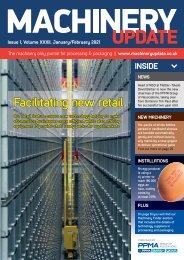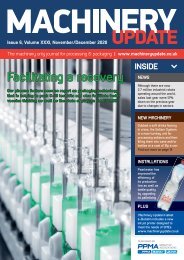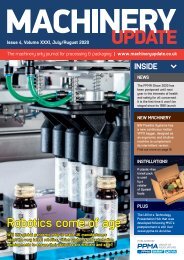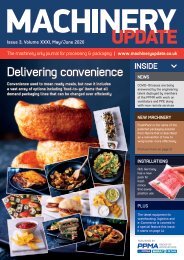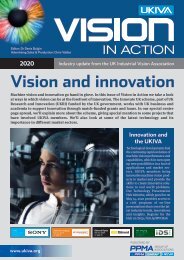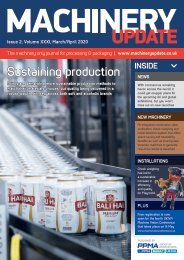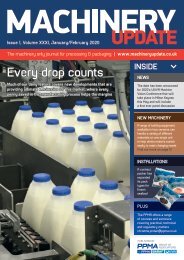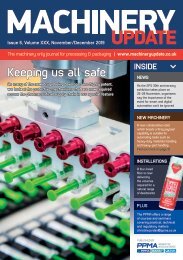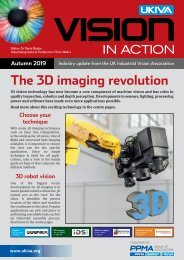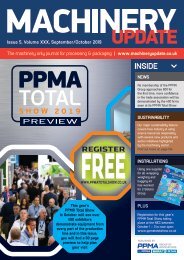Machinery Update | March / April 2021
You also want an ePaper? Increase the reach of your titles
YUMPU automatically turns print PDFs into web optimized ePapers that Google loves.
10 MACHINERY UPDATE MARCH/APRIL <strong>2021</strong> www.machineryupdate.co.uk<br />
Regulations<br />
Keeping machinery<br />
compliant post-Brexit<br />
Paul Taylor<br />
HEAD OF INDUSTRIAL PRODUCTS (UK)<br />
Now that the UK has left the EU, machinery end-users will start to see a UKCA mark appearing<br />
on compliant products and here, we cover what to look out for, and action, post-Brexit…<br />
Today, the vast majority<br />
of UK law is made<br />
through Statutory<br />
Instruments. The European<br />
Union (Withdrawal) Act 2018<br />
and the European Union<br />
(Withdrawal Agreement)<br />
Act 2020 allow Statutory<br />
Instruments to be made which<br />
rescind and amend legislation<br />
which originally emanated<br />
from Europe. These Statutory<br />
Instruments are referred to<br />
as the ‘EU Exit’ Statutory<br />
Instruments.<br />
Now that the United<br />
Kingdom has left the EU,<br />
machinery end-users in the<br />
UK will slowly start to see<br />
a UKCA mark appearing on<br />
compliant products. UKCA<br />
marking was specified in the<br />
original EU Exit Statutory<br />
Instruments and indicates<br />
that a product placed on the<br />
market meets the UK’s new<br />
regulatory requirements. For<br />
most products this is defined<br />
in UK Statutory Instrument<br />
2019 No 696, with the original<br />
CE marking regulations being<br />
amended rather than replaced.<br />
SAME STANDARDS<br />
While references to<br />
“harmonised standards”<br />
have changed to ‘designated<br />
standards’, for now the UK<br />
standards remain the same<br />
as EU harmonised standards<br />
and have simply been carried<br />
across as UK designated<br />
standards in order to maintain<br />
a single model. This means<br />
that in the UK, procedures<br />
have changed very little from<br />
the CE marking structure.<br />
However, while initially these<br />
requirements will align with<br />
the CE marking ones that they<br />
replace, overtime divergence<br />
is still possible.<br />
The CE marking will of<br />
course remain in the EU.<br />
In both jurisdictions the same<br />
rules will apply for designers,<br />
manufacturers and importers<br />
– everyone must understand<br />
their legal duties and their<br />
responsibilities.<br />
Since the EU exit transition<br />
period came to an end on 31st<br />
December 2020, the UKCA<br />
marking is now required for<br />
new machinery placed on<br />
the market for the first time<br />
in Great Britain (England,<br />
Scotland and Wales), but<br />
CE marking will continue<br />
to be accepted in Northern<br />
Ireland. However, machinery<br />
manufacturers do have<br />
10 months grace in the form<br />
of a further transitional<br />
arrangement for the<br />
acceptance of CE marking<br />
until 1st January 2022.<br />
After this time any machinery<br />
sold in the UK, irrespective<br />
of when that model was first<br />
placed on the market, must<br />
carry a UKCA marking.<br />
It is therefore vital that<br />
machinery end-users are<br />
aware of what their suppliers<br />
should be doing.<br />
This means that all machinery<br />
should meet all relevant<br />
essential health and safety<br />
requirements (EHSRs).<br />
These are detailed in the<br />
UKCA Regulations and include<br />
the provision of sufficient<br />
instructions in the language<br />
of the end user. A technical<br />
file for the machinery should<br />
also be available.<br />
<strong>Machinery</strong> will additionally<br />
require a UK Declaration of<br />
Conformity, or in the case of<br />
partly completed machinery,<br />
a Declaration of Incorporation.<br />
This will need to list UK<br />
legislation and UK designated<br />
standards for compliance.<br />
For specific higher risk<br />
machinery that requires<br />
New UKCA marking presents<br />
machine builders with the challenge<br />
of complying in a tight timescale<br />
type-examination by a<br />
certification body, a UK<br />
Approved Body will be required.<br />
From the 1st January <strong>2021</strong>,<br />
UK-based EU notified bodies<br />
automatically became<br />
UK Approved Bodies for<br />
their previous scope of EU<br />
accreditation, allowing UKCA<br />
certification work to commence.<br />
As we do not have an EU/UK<br />
Mutual Recognition<br />
Agreement (MRA), UK-based<br />
approved bodies will no longer<br />
be recognised in Europe for<br />
CE marking, and EU-based<br />
notified bodies will not be<br />
recognised as UKCA approved<br />
bodies after the 1 January <strong>2021</strong>.<br />
However, the most significant<br />
impact has been on the<br />
location of the manufacturer.<br />
UK companies exporting<br />
CE marked equipment into<br />
the EU must appoint a<br />
responsible person that is<br />
authorised to compile the<br />
technical file, and they<br />
must be physically located<br />
within the EU.<br />
SELF-DECLARATION<br />
The manufacturer is still<br />
allowed to self-declare a<br />
product’s compliance where<br />
applicable. This responsible<br />
person or entity is the same<br />
requirement that has been<br />
applied for many years to any<br />
other country outside of the<br />
EU. This is reciprocated for<br />
EU entities importing into<br />
the UK. Quite simply,<br />
post-exit from the EU, the<br />
UK is operating a separate<br />
regulatory regime just like<br />
the rest of the world.<br />
Despite this additional<br />
time, the introduction of the<br />
new UKCA marking presents<br />
machinery manufacturers<br />
with the challenge of<br />
ensuring compliance with<br />
a new conformity assessment<br />
mark within a relatively tight<br />
timescale. As UKCA markings<br />
are a visible sign that a<br />
product complies with all the<br />
relevant UK regulations, it is<br />
essential that machinery endusers<br />
understand both their<br />
responsibilities and those of<br />
their machine’s manufacturer.<br />
i For more information contact<br />
W www.tuv-sud.co.uk<br />
TÜV SÜD is the PPMA<br />
Group’s technical and<br />
legislative partner




